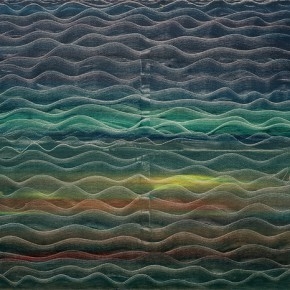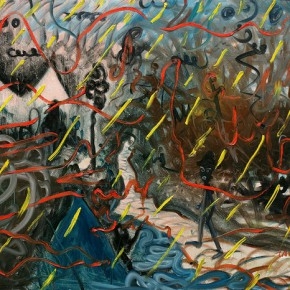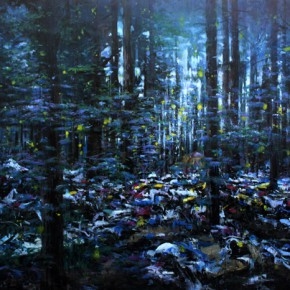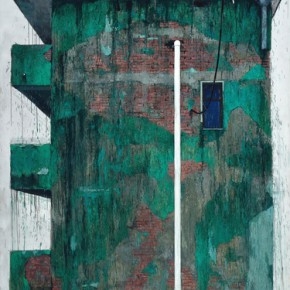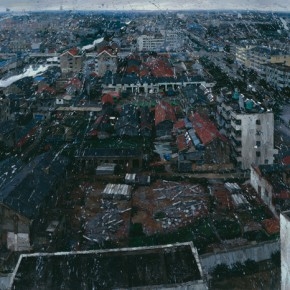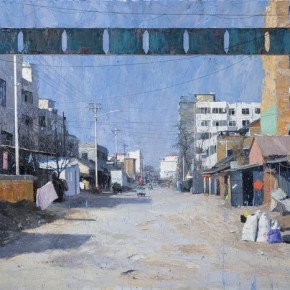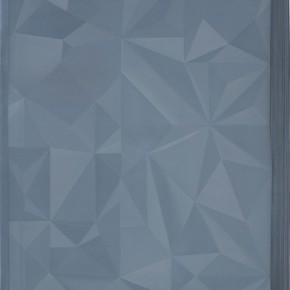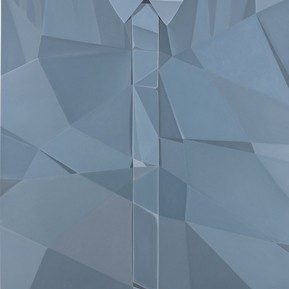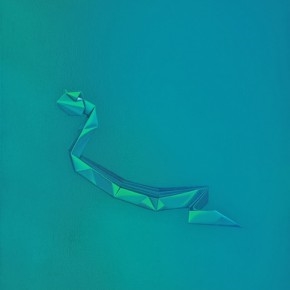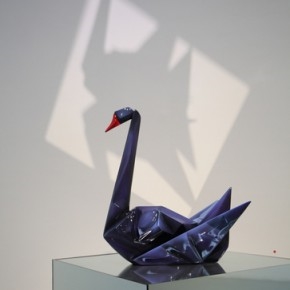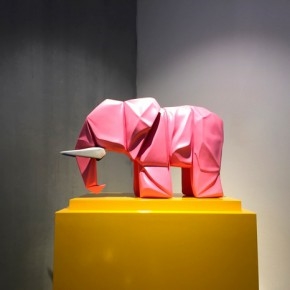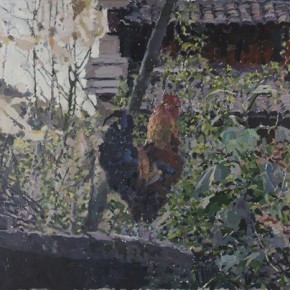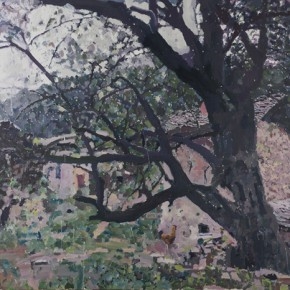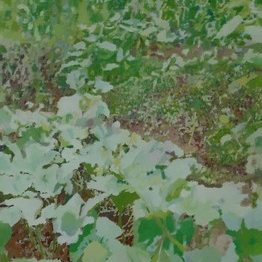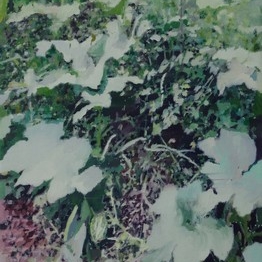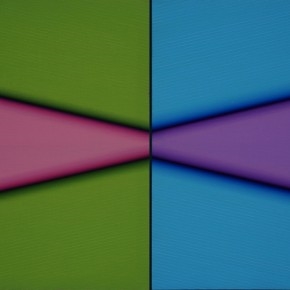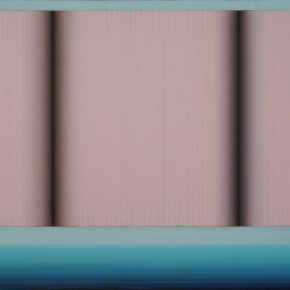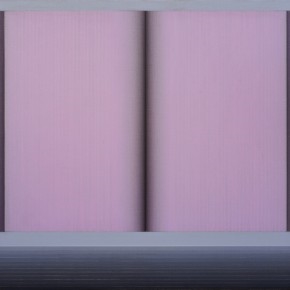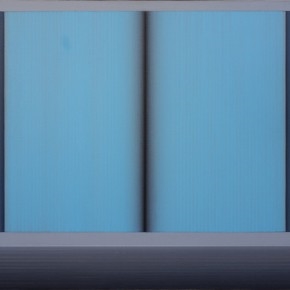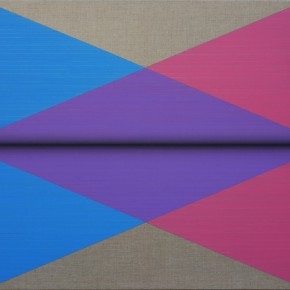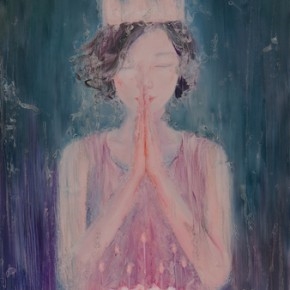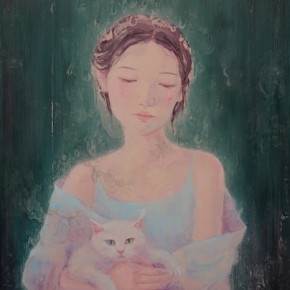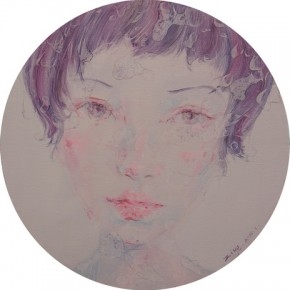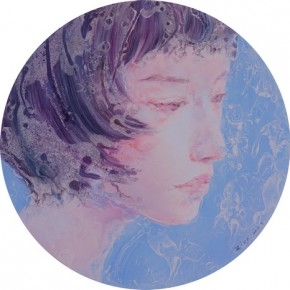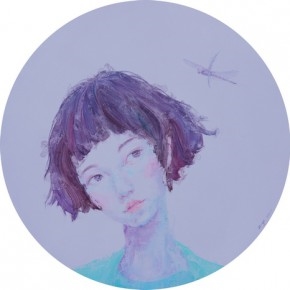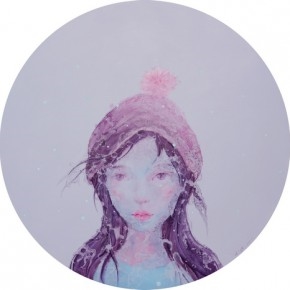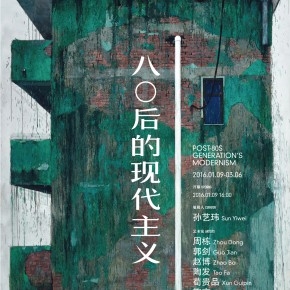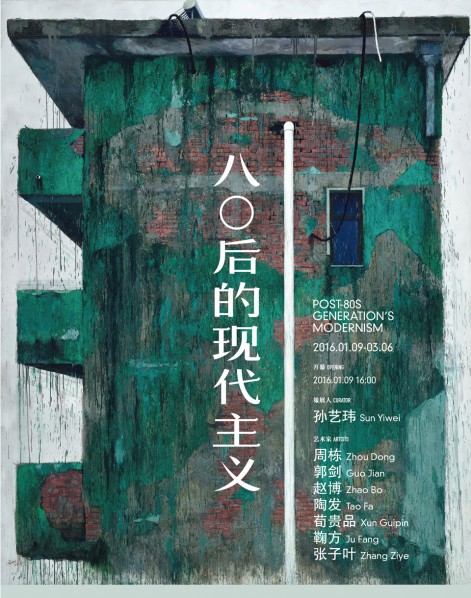
Post-80s Generation’s Modernism
By Sun Yiwei
It took Westerners nearly 500 years before their realistic art, or classical art, reached its peak. In the second half of the nineteenth century, artists slowly began to abandon realism. Aesthetically, there was a departure from a focus on the object and more attention was paid to the basic visual art form elements. The form was reshaped, and there was an emphasis on the artist’s subjective arrangement of the image, which led to the creation of abstract art. The phase of Western modernist art had begun. Modern art was a revolution. This revolution started with Cezanne, followed by Gauguin, Van Gogh, Picasso, and Matisse. One after the other, they created a new painting language. No longer was there a pursuit for realism, as there was in classical art, but instead there was a pursuit for natural beauty, which meant creating more “significant forms”. With the pursuit of “artistic beauty”, artists started to make “art for art’s sake”. In the history of art, the definition of “Modern Art” mainly refers to the era of 1860 to 1960. After 1960, the emergence of pop art meant that art had entered yet another new phase. It was now possible to completely disregard the form and not pursue beauty or the form that modern artists emphasized. The important thing was for the artists to convey their ideas and express their concepts. Furthermore, this medium could embody any method or object you could think of, or simply life itself. Art could be ugly, lost, revolting, even anti-beautiful or amoral. The stage was now set for “contemporary art”. But in fact, the reality was that “Classical Art” could not be said to have been lost, or that there was no “Modern Art” after 1960. Up until now, Classical Art and Modern Art still exist, but they are no longer part of the mainstream, but both have become art categories. Works of formalism and conceptual art are constantly being created, enriching the historical development of art.
Was Modern Art halted by the abstract? Can current art all collectively be called contemporary art? Danto once said, “For a long time, I think, ‘contemporary art’ would have been just Modern Art that is being made now.” As more and more artists with a variety of methods for creating anti-art appeared, he slowly came to realize that “contemporary has come to mean an art produced within a certain structure of production never, I think, seen before in the entire history of art…I wish to draw a very strong distinction between ‘modern’ and ‘contemporary’." Modern Art promotes artistic beauty. This is judged primarily by its innovation in form, which ultimately is how contemporary art can be distinguished. After the 1960s, conceptual art became very popular. There are still some artists who are exploring in the direction of modern art, without departing from easel painting itself, without departing from formalism or the pursuit of “artistic beauty”. On the premise of not departing from easel painting itself, the possibility for more artistic beauty was explored. The entire process of modern Western art going from the realistic to the abstract took nearly a hundred years. The Chinese modern art phase started in 1985, mere two or three decades, and cannot possibly have reached its end. In present-day China, apart from dynamic and genuine contemporary artists who with a positive attitude engage in image, behavior, installation, and new-media creations, there are many artists who adhere to the core of modern art development, without departing from formalism. In this context, I invite seven post-80s artists, namely: Zhou Dong, Guo Jian, Zhao Bo, Tao Fa, Xu Guipin, Ju Fang, and Zhang Ziye. An attempt is made for more sustainable concept of Modern Art. Particularly in China, the Western modernism period is not a part of past history. Instead, emerging, young artists continue to emerge and express themselves in different ways through easel painting. Combined with diverse personal geographical or cultural backgrounds, more substantial art is created, and a diversification in modern art is taking place.
Zhou Dong (1980- )
Born in 1980, Dong Zhou graduated from the Third Studio of Oil Painting Department of the Central Academy of Fine Arts. In his paintings, viewers can see tattered urban tenements, a shattered town corner, and humble people in a small humble town. Over China’s rapid change in the past few decades, the conservative simple era is no more; instead, numerous small towns have become the most realistic first sites of the developing China. The chaotic townlet scenes that seem to be too tedious to be used as painting materials came to life under Dong Zhou’s brush, stunning and moving. Thousands of towns which are in development in the new China, and the realism of the overlooked disorder are portrayed, enlarged, and presented in Dong Zhou’s works. Behind the cold, disorderly, bustling, chaotic town scenes are the innumerable ordinary people trying to survive in the drastically changing Chinese society, lively, desiring yet frustrated. Dong Zhou said, “I’m getting more concerned about the people and the scenes that are lost in the rapidly changing external world.” Those unremarkable people, scenes, and objects are so vivid in Dong Zhou’s portrayals. Most of his pieces were done directly by life sketching. He carried his sketchpads shuttling among the busy towns. In the voice of the restless towns, the Chinese-style landscape and people’s living environments are presented by a large scale. Dong Zhou’s language of art is plain yet contains a powerful strength, which brings you to the nature of China’s reality, and makes you feel the heat of an ordinary life. He went deep into the primary scenes, and sketched out his first instincts of the scenes with his paintbrushes. The scenes were restless, anxious, and melancholy. Eventually, what’s in his painting turned into the moment of eternal, and became the real microcosm of society that grew with the artist.
Guo Jian (1982- )
Born in 1982, Guo Jian graduated from the Department of Oil Painting at Xi'an Academy of Fine Arts. In 2008, he started his Polaroid series, depicting the images of two separated former lovers across different times, spaces, moods, and scenes. Clean, bright colors, cartoon-like figures, and lonely thoughts permeate the screen. From 2011 onwards, “origami” became most important expressive element in his works. Guo embedded “origami” into his flat canvases, demonstrating unexpected spatial effects. Paper cranes, frogs, shirts, and other shapes that Guo folded as a child have leapt from the three-dimensional origami space and into Guo’s exquisite flat canvas. Amidst a simple background, the origami images are also formed by simple geometric blocks of color. He continues to evolve originally common origami images by detaching them from reality, using controllable color blocks and lines of oil painting to create new spatial order. Guo believes that origami and people are very similar. He says, “When people are born, they are like a blank sheet of paper. As they grow up and experience many things, they get repeatedly folded like origami. Regardless of success or failure, everyone will eventually arrive at the end of their life and become a fixed shape. At the last fold, you might become a black swan or a ball of paper. I think it does not matter. The most important thing is you have experienced the interesting process of origami. You cannot smooth over these traces.” This is probably one of the reasons why he later used “origami” as an important source for screen space and color exploration. His clean and simple paintings convey the artist’s own delicate sentiments as well as his keen chase for life. Ultimately, Guo subjectively presents paintings and sculptures without departing from the frame of formal beauty. This is Guo’s modernism.
Zhao Bo (1984- )
Born in 1984, Zhao Bo graduated from the Department of Oil Painting at Luxun Academy of Fine Arts. Zhao Bo’s works are often spacious, oblique and barren, with a sense of uncertainty, lack of sense of belonging and anxiousness hidden in them. Pyramids are placed on top on of a frozen river that is endless in sight. Meanwhile remains of a plane are abandoned in a sea of flowers. There are abandoned places, forests that are full of life and leafless branches. Behind these dreamy, beautiful scapes, shapes that take on the forms of endangered animals or heroic space pilots are placed right in the middle. Zhao Bo takes his chosen objects and puts them in places that don’t belong to Zhao Bo’s creations. The characteristic about Zhao Bo’s works is the sense of surrealism and the use of ridiculous, dreamlike colors. Behind the illogical placement is the momentary state of human Ideology that Zhao Bo discovers. He hopes the audience gets lost in the images he creates and leaves the fictitious sensual world of reality. This way, we can reflect on the authenticity of our awareness of survival. On the one side of the image is reality, the other is fantasy. Zhao Bo’s solid academic skill for realism allows him to place reality and fiction side by side freely. He takes the audience in with sketches of shapes, then derives from them a lot of unreal hidden contradictions and conflicts. All these are seemingly harmonious, but are actually discordant, fantasy visual images. Zhao Bo paints a visual image of "One Hundred Years of Solitude" and in it, the rhythms and melodies of the picture come together to form an overriding harmony. Every point, every line, every side or different block of color ultimately forms a complete image representing the artist’s ideas towards the implications that our ideology imbues upon our state of living. He is constantly contemplating whilst remaining true to life. Not only did he not fall into the system of conceptualization, he found "A Beautiful New World" through his works.
Tao Fa (1984- )
Tao Fa is Miao. Born in Yunnan in 1984, Tao graduated from the Art and Design Department of Yunnan University. He is one of the beloved protégées of Mao Xuhui. What Yunnan is to Tao Fa is like what Tahiti is to Gauguin. With influence from the Hmong origin mythology and the Qin Dynasty’s “The Classics of Mountains and Seas”, Tao’s works are full of primitive and mysterious power, like that in mythology. There is often a great amount of classical blues in his pieces. Tao’s works are not about judging society. Rather, they express emotions about nature and the forests of Yunnan that he grew up with. Tao inserts the polytheistic faith of the ethnic group in his works by giving the trees and mountains souls and life force. He often works after having a few drinks. With the help of the buzz from the alcohol, Tao expresses himself freely through painting. The stream of unconscious movements then becomes a scene. There are often symbols that look like mysterious words, conversing amongst themselves, appearing in his works. They express a primitive, plain aesthetic of a mysterious nature. Tao poetically gives souls to the wasteland, forests or farmlands from his childhood. Although there is no element of society in his works, the audience can still relate to them. They can re-discover the ordinary world of nature. The state of his creations is extremely free. The works are full of emotions while simultaneously pointing out the original state of life. Tao’s use of classical Eastern colors and random unadorned lines form natural, classical aesthetics.
Xun Guipin (1985- )
A student of Mao Xuhui, Xun Guipin was born in Yunnan in 1985 and graduated from the School of Art and Design at Yunnan University. Xun utilizes colored dots to shine sunlight onto the rural land of Yunnan. He screens these ordinary countryside scenes through his own visual perception. Finally, he embeds color abstraction into his paintings to form a kind of disordered illusion, a colorfully transformed visual perception. Xun was probably the most diligent among Mao’s students. He devoutly illustrates his direct perception of natural life onto the canvas. Inconspicuous country land, vegetable gardens, walnut trees, and wandering roosters are honestly presently in Xun’s stunning paintings. The act of using color blocks that affect the light in his paintings is influenced by Impressionism. In some works, we cannot see the source of light, yet we sense that the light is ubiquitous. He completely hands over his works to nature, to the mountains in Yunnan that he grew up with. Each tree, flower, and piece of red soil serve as his most direct source of inspiration. This is just like what Xun says, “My land is the canvas. I wish to interact with trees, flowers, and grass, and become a seed within the soil, where I will integrate into the embrace of the earth. In my constant actions of internalization and introspection, I grasp the spirit of natural philosophy. Nature is a burial ground. Every place is the best destination and spiritual home for life.”
Ju Fang (1985 - )
Born in 1985, Ju Fang graduated from the Department of Oil Painting at Shenyang University. Visually, people tend to describe his work as “abstract”. Interestingly, the artist himself has never thought of his works to be abstract paintings. Ju often needs to calculate trigonometric functions or simple geometry which would usually decide the specific location of a line or color block before painting. In the beginning, his creation began with painting a book. His depiction of the book fostered his most direct experience towards life or living. In the process of his repeated actions, countless lines of different colors construct a surface, where minor differences shape the sense of space within the gaps between the pages of every book. He is fascinated with this visual sense. The picture subtly generates a sense of space which contains a great amount of focus and effort by the artist behind each “line”. With no text on the pages, the books, which the artist subjectively chose different colors to illustrate, were ultimately minimalized and conveyed in an abstract visual form. The color choices on the painting are also strictly controlled to be of the same brightness. After abstract, the works are extremely figurative. Absolute abstract does not exist in the artist’s paintings, and nor does absolute figurativism. Are they abstract or figurative? This depends on the perspectives each viewer uses to see his works. Ju’s painting language is constructed upon extremely rational and mathematically accurate calculations. Finally, the book becomes the carrier, recording his perceptual awareness towards life.
Zhang Ziyi (1988- )
Zhang Ziyi was born in 1988 and graduated from the Department of Oil Painting at Sichuan Academy of Fine Arts. Most characteristic of Zhang's works is the use of dilute paint to recreate the sense of mist flowing forth found in Chinese ink paintings. In her works are absent the weighted, bulky feel typically found in oil paintings. Instead, the images she creates seem to move gracefully about, almost as if they were alive and breathing. The subject of Zhang's paintings is most often that of a youthful, beautiful girl, or animals. Hidden behind the gaze of each of these beautiful, vividly painted faces, is an unspeakable sense of youthful angst. These mottled images are like the memories of our youth which we all once had, memories once crystal clear that have now become blurred. With the passing of time, we leave our youth further and further behind. Zhang Ziyi states that, "Painting is something that brings me a great amount of joy, and it's also something I find great pride in doing." Through her paintings, Zhang Ziyi pulls us back into the times of our youth. Her paintings tell us that youth is beautiful, but also difficult and accompanied by growing pains. After the pain and the hurt, we each grow up, yet are never able to return to that period of time in our youth which grows ever more distant. Sometimes, painters become storytellers. Using brushes and using heart, painters capture and record the things most people glance over without noticing to in the end create a beautiful painting; paintings which awaken the memories which lie sleeping deep within our memories. As a part of the younger generation, Zhang Ziyi is even more willing to call herself a painter. In this age, it is not easy to find members of the younger generation that are willing to dedicate themselves so entirely to painting, but Zhang Ziyi is one who has.
In my opinion, for an artist to not give up on painting, means that they haven't given up on the expression of modernism. The final presentation still pursues "artistic beauty," and has not given up on formalism's emphasis of form over content. The artistic styles of the seven artists invited are all uniquely different from one another. The only point of similarity is that they were all born after 1980 and have all chosen easel painting as their primary method of creation for the realization of modern art. During their journey in creating and using painting as a language, these young artists born after the 1980s, have managed to present their stories from their constant artistic explorations with strongly unique methods of expression, to enrich the different aspects of modern art, and bring the audience a new, refreshing visual experience.
December 15, 2015
About the exhibition
Date: 2016-01-09—03-06
Venue: Soka Art Center
Courtesy of the artists and Soka Art Center.


